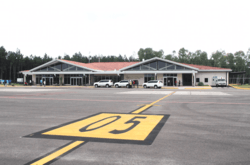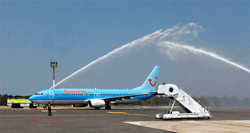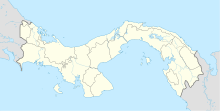Scarlett Martínez International Airport facts for kids
Quick facts for kids
Scarlett Martínez International Airport
Rio Hato Airport
|
|||||||||||
|---|---|---|---|---|---|---|---|---|---|---|---|

Terminal building seen from the runway
|
|||||||||||

Sunwing Airlines inaugural flight, 2015
|
|||||||||||
| Summary | |||||||||||
| Airport type | Public | ||||||||||
| Serves | Rio Hato, Panama | ||||||||||
| Elevation AMSL | 121 ft / 37 m | ||||||||||
| Coordinates | 8°22′33″N 80°07′40″W / 8.37583°N 80.12778°W | ||||||||||
| Map | |||||||||||
| Runway | |||||||||||
|
|||||||||||
|
Source: GCM SkyVector Google Maps
|
|||||||||||
Scarlett Martínez International Airport (IATA: RIH, ICAO: MPSM), also known as Río Hato Airport, is an international airport in Río Hato, a town in the Coclé Province of Panama. It is located about 3 kilometers (2 miles) east of Río Hato. This airport helps connect travelers to Panama's beautiful Pacific beaches.
Contents
Why is Scarlett Martínez an International Airport?
In 2011, the government of Panama decided to rebuild and improve the airport. This big project cost about $53.2 million. The goal was to make it a modern international airport.
What improvements were made?
The work included fixing the runway and building a new airport terminal. They also built a special tunnel for the Pan-American Highway. This highway used to cross the runway, which was not safe. The project took about 14 months to finish.
How does the airport help Panama?
Panama's President, Ricardo Martinelli, officially opened the new airport on November 13, 2013. He said it would bring many good things for people living nearby. The airport helps Tocumen International Airport in Panama City by taking some flights. This helps Panama become an important place for business and travel in the region.
The airport also helps boost tourism along Panama's Pacific beaches. Many resorts and hotels are located there. Charter airlines from the United States, Canada, and Europe use this airport.
Where is the runway located?
The airport's runway is about 0.5 kilometers (0.3 miles) inland from the Pacific Ocean. This means planes flying in or out from the south will be over the water. There is also a special navigation beacon called Rio Hato VOR-DME (RHT) at the airport.
Airlines and Destinations
This airport serves several airlines, offering both regular and seasonal flights.
| Airlines | Destinations |
|---|---|
| Air Panama | Charter: Panama City-Albrook |
| Air Transat | Seasonal: Montreal–Trudeau, Toronto–Pearson |
| Arrendamientos Aéreos | Charter: Panama City-Albrook |
| Sunwing Airlines | Toronto–Pearson |
History of Río Hato Airport
The airport has a long and interesting history, including its use as a military base.
Río Hato Army Air Base
The airport was first set up in 1931. During World War II, it became a very important military base for the United States Army Air Forces. It was called Río Hato Army Air Base. Its main job was to help defend the Panama Canal.
The base stopped being an active Air Force facility in 1948. However, it was still used as a backup military landing field until 1990.
Operation Just Cause
Río Hato played a role in a military operation called Operation Just Cause in 1989. This operation involved the United States military.
Rangers' Mission at Río Hato
On December 19, 1989, two groups of US Army Rangers (the 2nd and 3rd Battalions of the 75th Ranger Regiment) flew from Georgia, USA. Their mission was to take control of Río Hato airfield. They also needed to deal with two Panamanian military companies located there.
At 1:00 AM on December 20, the Rangers parachuted onto the airfield. The Panamanian soldiers were ready and fired at the planes. Despite the resistance, the Rangers gathered, attacked the barracks (military living quarters), and secured the airfield. By morning, they had completed their mission and captured many prisoners.
Stealth Fighter's Role
Río Hato was also the first combat target for the US Air Force's Lockheed F-117 Nighthawk stealth fighter. This special aircraft is designed to be hard to detect by radar.
On December 19, 1989, a group of eight F-117s took off from Nevada, USA. Their target was an open field near barracks where elite Panamanian troops were staying. The plan was to drop two large 2,000-pound bombs. These bombs were meant to stun the sleeping soldiers with their powerful explosions. This would prevent them from fighting back when the Rangers landed nearby.
However, things did not go exactly as planned. The wind changed direction. Also, a last-minute change in the attack plan and confused messages led to one pilot dropping his bomb in the wrong spot. The other pilot then dropped his bomb much farther away than intended.
Images for kids
-
Sunwing Airlines inaugural flight, 2015
See also
 In Spanish: Aeropuerto Internacional Scarlett Martínez para niños
In Spanish: Aeropuerto Internacional Scarlett Martínez para niños




